Skip to content
If you’re a first time cat owner, chances are you have a lot of questions about how to welcome your new feline friend into your home. And even if you’ve had many cats before, there’s still a lot to learn about proper cat care, such as food, water, litterboxes, enrichment, grooming, medical care, and more. Fortunately, we’re here to help! We’ve compiled a large collection of resources on this page to support you, no matter where you are in your knowledge. Please note that Tabby’s Place does not endorse any specific products or companies that may be referenced in this article.
Feeding
Cats require a well balanced diet which is specifically formulated for cats. There are also different foods for kittens with additional nutrients and calories to support their growth. We recommend feeding canned food twice daily and providing dry food by free-feeding, meal-feeding, or using puzzle feeders, depending on the health, activity level, and life stage of your cat.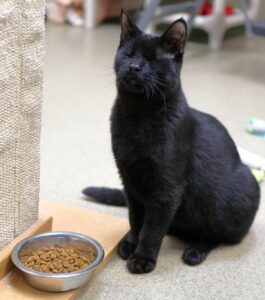
- Free-feeding involves leaving dry food out all the time (making sure to change old food out every day) for cats to graze on when they would like. Kittens should always have access dry food, as they are still growing and need the extra nutrients. Older cats with health issues may also need increased access to dry food, and your veterinarian can guide you on appropriate amounts. However, some adult cats take free-feeding a little too seriously and eat too much. If you choose to free-feed, monitor your kitty’s weight to ensure they don’t get too chubby. If they do, you can utilize one of the other methods listed below to help keep them at a healthy weight.
- Meal-feeding involves providing your cat with smaller portions of dry food at specific times during the day, which helps prevent them from eating too much in one sitting. We generally recommend feeding adult cats 1/2 cup dry food per cat each day. With meal feeding, you could provide your cat with 1/4 cup dry food in both the morning and the evening. Alternatively, you could space out their food even further by providing 1/8 cup dry food 3-4 times per day. This can help with chubbier cats who may protest the limiting of their food. You can even purchase an automated feeder, such as this one, which automatically dispenses pre-portioned amounts of food at specific times during the day.
- Puzzle feeders are another great way to help manage your cat’s intake of food while also engaging their natural hunting instincts. When using this method, monitor to ensure your cat is still able to access and eat their food. Some cats will take to puzzle feeders immediately, while others may require some extra guidance and training. If your cat is having trouble, you can start by putting food just on the outermost or most accessible part of the feeder to let them get used to it. Some puzzle feeders may also be easier or harder for your cat to use, so you can try a few different types to see if one works better for your kitty. In some cases, a cat may not want to use puzzle feeders at all, and that’s okay too! Some dry food puzzle feeders that we use include Doc & Phoebe Mice, Catit Diggers, Slow Feeders, and Hide N’ Slides, but there are many other great ones as well. You can also utilize lick mats, such as this one, for wet food.
Make sure to limit how much human food you feed your cat, and be aware of foods that are toxic to cats, such as chocolate or grapes. You can refer to this article from Hill’s for a comprehensive list of foods to avoid.
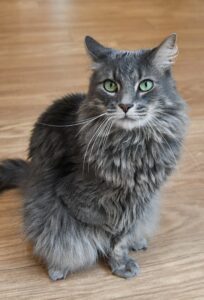 Water
Water
Ensuring your cat stays hydrated is necessary for maintaining their overall health. It’s especially important for supporting their urinary tract, as it can help prevent urinary blockages, stones, and crystals. Adequate hydration can also prevent or slow down the progression of chronic kidney disease, which is a very common condition among older cats.
A fountain with fresh, moving water can help encourage drinking (or sometimes even the faucet on the sink)! Some cats may be spooked by the running water, so check to make sure they are still drinking from a new fountain. You may want to continue offering a bowl of fresh still water daily.
Another good way to keep your kitty hydrated is by adding a little extra water to your cat’s wet food portions. Pate food especially should be mixed well with extra water.
Litterboxes
It’s very important that your kitty has a safe, clean, and comfortable place to go to the bathroom. Cats can be very picky about their litterbox, so we’ve included some helpful information below to make things as easy as possible for both you and your feline family member.
- Litter Type: Most cats prefer fine, sandy litter, and might not like larger textures such as pellets or crystals. Cats also prefer unscented litter, as some scents can be overwhelming, deterring them from using the litter box. If you would like to try a different type of litter than your cat is currently using, offer your cat an extra box with this litter. If they use this as much as or more often than the current litter, you can transition to the new litter. However, your kitty may not like the new litter, and if so, you’ll need to keep using the old litter.
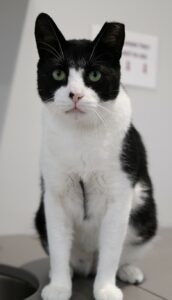
- Litter Box Type: It’s important that your cat’s litter box matches their needs. Young kittens and older cats who have mobility limitations may need a lower entry litter pan. Ideally, you want a litter box that is at least 1.5 times the length of the cat’s body, so they can easily fit inside and turn around. Many commercial litter boxes are not big enough for most cats. Cats also prefer an uncovered litter box, allowing them to see their surroundings while they use the bathroom. Contrary to popular belief, covered litter boxes do not provide cats with privacy, but instead prevent them from seeing what’s around them and make them wary of using the box. If your cat is messy with their litter, you can use a high-sided litter pan, such as this one. You can also try a covered litter pan with a see-through top that allows them to look at their surroundings, such as this one. Be aware that they may not want to use a covered box, even with a see-through top, and if so will need to be provided with an uncovered option.
- Litter Box Location: Litter boxes should be easily accessible to your cat. If possible, the litter box should not be kept in the basement, especially if it’s the only one. Cabinets designed to hide litter boxes are also not ideal, as they can make it more difficult for your cat to get into the box and also prevent them from seeing their surroundings, which can deter them from using the box. We recommend keeping one litter box on each floor of a home, even if you only have one cat, so that they are readily available. If you have multiple cats, it’s especially important to have litterboxes in multiple locations to prevent one or more of them from “guarding” the litter box. Older cats and kittens may need extra litter boxes, as they may not be able to wait long to use the bathroom or they may have trouble walking long distances or climbing stairs to reach the litterbox.
- Litter Box Cleaning: By nature, cats are very clean, and just like humans, they do not like using a dirty bathroom. We recommend scooping your litter box at least once daily and thoroughly cleaning it out every month, or as needed depending on the frequency of use. Make sure to use a pet safe cleaner with a mild scent, such as Dawn dish soap, when cleaning the litter box. Strong scents can be overwhelming to cats and may deter them from using the litterbox.
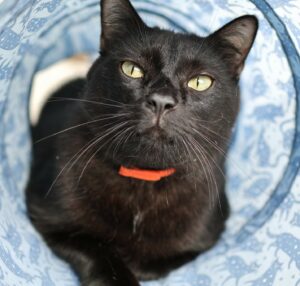 Health
Health
One of the best things you can do to support the health of your cat is keeping up with annual vet visits. Just like humans, cats need to go to doctor every year! Even if your cat is young and seems to be in good health, having a vet take a good look can help detect illnesses early so you can treat them before they progress. It’s also important to stay up to date on core vaccines, such as rabies and FVRCP, which help protect against some of the most deadly illnesses in cats.
Cats can also be very good at hiding when they don’t feel well, so it’s important to keep a close eye on them. Some tell-tale signs of illness include sudden changes in behavior, vocalization, urinating/defecating outside of the litter box, straining in the litterbox, vomiting, diarrhea, lack of appetite, and lethargy. While all of these symptoms warrant examination by a veterinarian, it’s important to know what constitutes an immediate trip to the emergency hospital or what can wait a couple days for a sick appointment with a regular vet.
Take your cat to the emergency vet immediately if you notice any of these life-threatening symptoms:
- Straining/being unable to urinate
- Severe bleeding
- Collapse
- Trouble breathing, which includes symptoms such as nostril flaring, cheek puffing, open mouth breathing, and increased respiratory effort/rate
- Severe vomiting and diarrhea
- Obvious broken bones
- Severe pain
- Dragging back legs/no feeling in back legs
- New onset neurological signs (such as decreased balance/coordination or unresponsiveness)
- Seizures: one lasting more than 5 minutes or multiple back-to-back seizures
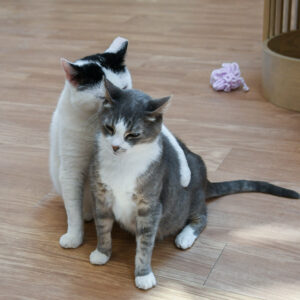
Grooming
Healthy cats are normally very good at grooming themselves, and don’t require human intervention. However, long-haired cats are often prone to matting and require more frequent brushings or even shave-downs. Older cats may also have more trouble cleaning themselves, so it’s a good idea to get them used to being brushed.
Most cats will need to have their nails trimmed regularly, usually about once a month. Pet nail clippers can be purchased online or at any pet store. If it’s your first time cutting a cat’s nails, ask your vet or our adoption counselors to show you how to do it properly and avoid accidentally injuring your cat. Typically, nail trimming works best with two people: one holding the cat and one trimming the nails, as it can be an upsetting experience for your kitty. You can try using rewards such as treats or squeeze ups during nail trimming or brushing to help distract your kitty and create positive associations.
Enrichment
Providing mental stimulation to your kitty is a great way to support their physical and behavioral needs. Enrichment helps cats feel comfortable in their home, and provides healthy outlets for their natural behaviors. Providing your cat with lots of opportunities for enrichment is key to keeping them happy and healthy! We’ve included lots of ideas for enrichment below, but there are of course many other options available.
- Wand toys are a common way to play with your kitty and help them engage in natural hunting behaviors. They can also be used as a tool to redirect high energy cats away from inappropriate methods of play (such as biting or swatting at hands) and towards more appropriate behaviors.
- Motorized toys are a great way to provide playtime to your kitty without the need for human help. If you work long hours and are not home often, this can help keep your kitties occupied
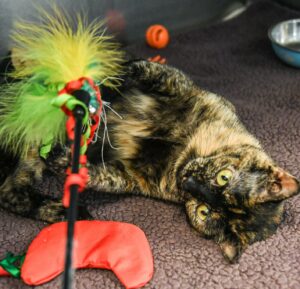 in your absence. Or, if you’re home, but trying to complete an important task, setting up a motorized toy in another room can be a fun way to distract your kitty.
in your absence. Or, if you’re home, but trying to complete an important task, setting up a motorized toy in another room can be a fun way to distract your kitty.
- Catnip, silvervine, and valerian root are all plants with a strong scent that can be very enticing to cats. Catnip in particular often brings out the silly side of cats and can also encourage shyer cats to come out in play. However, some cats are not affected by catnip, so don’t be deterred if your kitty prefers other methods of play.
- Scratching posts and boxes are a necessary item in your home if you have feline friends. Scratching is a natural behavior for cats, so it’s important to provide them with appropriate furniture to scratch on so they don’t turn to something else, like your couch or carpet. Some scratching posts also have dangling toys attached, which is another way to provide extra playtime for your cat.
- Cat trees serve a variety of purposes to enrich a cat’s life. They provide them with a safe space to view their surroundings, as well as get away from other pets if needed. They also give your kitty extra room to climb and play, and if placed near a window, allow them to watch the goings on outside of your home, which can keep them occupied for hours. Climbing is an innate behavior for cats, and they need to be able to engage in their natural instincts! If they are not provided with proper structures for this, like cat trees, they may instead turn to other furniture, such as your counter or bookshelf.
- Outdoor time, if done safely, can also improve your cat’s mental well-being. While unrestricted outdoor access poses many dangers, providing safe ways for cats to experience the great outdoors can provide a lot of beneficial stimulation. Confident, easygoing cats may like going for stroller walks in a well-made cat stroller, or enjoy walking on a harness and leash. If you have the resources, you can even build a fully secure outdoor enclosure attached to your home known as a “catio”, which allows cats to go in and out as they please.
Bedding
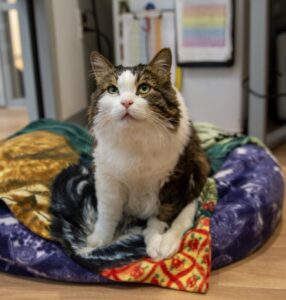 Cats spend up to 18 hours a day resting, and as such need access to comfortable places to sleep. You can never go wrong with a fluffy cat bed like this one, but shyer cats might prefer teepee beds or cubbies, which help them feel more secure. Cats also enjoy sleeping up high, so putting comfortable blankets on their favorite perches will help them feel that much more at home.
Cats spend up to 18 hours a day resting, and as such need access to comfortable places to sleep. You can never go wrong with a fluffy cat bed like this one, but shyer cats might prefer teepee beds or cubbies, which help them feel more secure. Cats also enjoy sleeping up high, so putting comfortable blankets on their favorite perches will help them feel that much more at home.
Carriers
You will want to make sure that you have a secure, roomy carrier to transport your cat in. We recommend purchasing a carrier with a door on the top as well as the side, such as this one, as this makes placing your cat in the carrier much easier. It’s also important to create positive associations with the carrier before you need to use it. Oftentimes, people will only bring out the carrier when it’s time to take their cat to the vet. This causes the cat to associate the carrier with going to the vet, leading them to immediately run away at the sight of it. To mitigate this, try leaving the carrier out in plain view all the time, or at least start doing so a few weeks before your scheduled vet appointment. This allows your kitty time to get used to the carrier, and makes it less of a frightening sight. You can also try feeding them treats inside the carrier, allowing them to get comfortable in it before they actually need to go anywhere.

 Water
Water
 Health
Health
 in your absence. Or, if you’re home, but trying to complete an important task, setting up a motorized toy in another room can be a fun way to distract your kitty.
in your absence. Or, if you’re home, but trying to complete an important task, setting up a motorized toy in another room can be a fun way to distract your kitty. Cats spend up to 18 hours a day resting, and as such need access to comfortable places to sleep. You can never go wrong with a fluffy cat bed like this one, but shyer cats might prefer teepee beds or cubbies, which help them feel more secure. Cats also enjoy sleeping up high, so putting comfortable blankets on their favorite perches will help them feel that much more at home.
Cats spend up to 18 hours a day resting, and as such need access to comfortable places to sleep. You can never go wrong with a fluffy cat bed like this one, but shyer cats might prefer teepee beds or cubbies, which help them feel more secure. Cats also enjoy sleeping up high, so putting comfortable blankets on their favorite perches will help them feel that much more at home.
